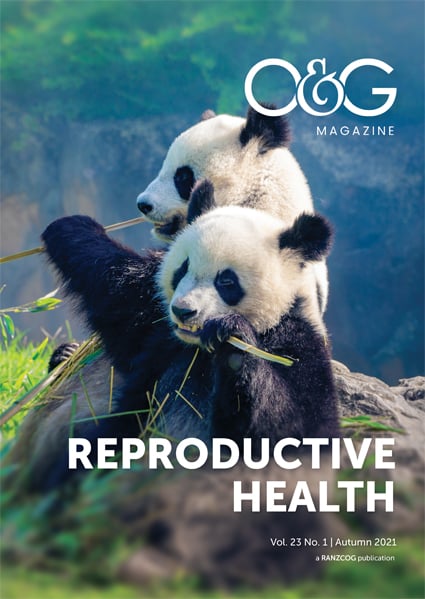For the woman
Acute complications
Complications of ovarian stimulation are well known. Ovarian cyst accidents include haemorrhage, rupture, ovarian hyperstimulation syndrome (OHSS) and, perhaps most serious, torsion. OHSS is now less common due to preventative measures such as judicious use of follicle-stimulating hormone (FSH), adjuvant metformin, gonadotropin-releasing hormone (GnRH), agonist induction of oocyte maturation, the decision to make the cycle a ‘freeze-all cycle’ and use of cabergoline after oocyte collection.1 Infection of the ovary is uncommon, but serious, as it is sometimes unrecognised and is associated with abscess formation.
Pregnancy complications
Pregnancy after assisted reproductive technology (ART) is different to pregnancy after natural conception, even if singleton and even with the use of cryopreserved embryos in natural ovulatory cycles. Gestational diabetes mellitus, polyhydramnios, oligohydramnios, preterm birth, low birth weight and birth weight which is small for gestational age are all increased.2 The risk of abnormalities of placentation is increased after fresh embryo transfer, placental abruption, placenta praevia and vasa praevia. After cryopreserved embryo gestational hypertension is consistently increased. Postpartum haemorrhage and thromboembolic disease associated with pregnancy is also increased in ART pregnancies.
Long term
The available evidence suggests that the lifelong risk of breast cancer and ovarian cancer are not increased after ART; however a woman is more likely to manifest breast cancer in the 12 months after an IVF cycle, much as she is after a pregnancy or after taking combined oral contraceptives. Having infertility is a risk factor for ovarian and uterine cancers, but these are not increased further by having an IVF cycle. There have been studies suggesting that borderline tumours of the ovary are increased in women having FSH treatment, but it is still controversial.
Aetiology of pregnancy and long-term complications for the female and its implications for practice
Debate about the association of complications of ART and the pathogenetic basis of obstetric and long-term health complications is ongoing. Whether women who access ART are at increased risk of these complications (and therefore may manifest them in natural conceptions) or whether the process of ART has a direct influence is uncertain. Women with reduced ovarian reserve and those with premature ovarian insufficiency (who may access donated oocytes) are at increased risk of a number of cardiovascular morbidities that may manifest as pregnancy-related hypertension and preeclampsia. Pregnancy following use of donated oocytes is associated with increased pregnancy-related hypertension, which may be the first manifestation of underlying cardiovascular risk. The long-term cardiovascular complications associated with early ovarian failure are only partially ameliorated by hormone replacement therapy. Preventative strategies for these long-term complications and risks potentially can be discussed with the woman at the time of fertility treatment, but timing of these discussions is often difficult and problematic as infertility tends to be an all-encompassing health issue for couples with infertility, and future considerations are often seen as less important. Written or spoken information with the patient and her partner and communication with the primary care physician may be useful but public information, education and community awareness will be of importance in the future.
For the man
There is no evidence that long-term health of men is affected by ART per se (excluding surgical sperm retrieval); however having an abnormal seminal fluid analysis, particularly oligospermia, is associated with an increased all-cause mortality.
Semen quality is a biomarker of male somatic health. One of the risks of ART for the man is forgone intervention opportunity if there is inadequate assessment of male reproductive health and general health. As many men are under the care of gynaecologists who have made a career commitment to women’s health, the opportunity to intervene to improve long-term health outcomes of men may be missed. Gynaecologists who offer fertility treatment in 2021 are expected to have skills in assessing men’s health, or have a close referral relationship within their health team to ensure that every man with an abnormal sperm count is examined and the implications for his long-term health and potential interventions are discussed with him.
Male factor infertility may be the first manifestation of pituitary disease or testosterone deficiency in the male. Medical assessment is also important if any erectile dysfunction is present. Men with abnormal sperm counts are at increased risk of testicular cancer and this is not influenced by ART. Physical examination with or without testicular ultrasound is a standard of care. Regular testicular self-examination is recommended with prompt presentation to a general practitioner should a lump or abnormality arise.
For the child
Ongoing review of children has established that children conceived by ART are at increased risk of congenital defects and of long-term adult disease (such as diabetes and high blood pressure) compared to naturally conceived children. Children conceived through IVF and intracytoplasmic sperm injection (ICSI) had a 30–40% increase in the risk of major congenital abnormalities compared to the risk in normally conceived children.3 A significant defect detectable at birth that requires treatment such as surgery occurs in 3 of every 100 naturally conceived children in the general population, but this incidence increases to at least 4 of every 100 children conceived with IVF/ICSI. The risk of birth defects is further increased by use of ICSI, particularly for male factor infertility.4 Higher estimates of birth defects are seen when children are assessed at a later age. A common birth defect after ART is infantile haemangioma, but many defects (blastogenesis, cardiovascular, musculoskeletal, genitourinary) are increased. Male offspring of men needing ICSI to conceive have lower sperm counts than those conceived naturally.5 Whether the birth defects result from the process of ART or whether the population accessing ART is at increased risk is uncertain. Evidence is conflicting.6
Epigenetic problems in children conceived by ART
ART procedures involve the culture and handling of embryos in the laboratory. It has been suggested that the laboratory environment may affect the way some genes are permanently switched on or off resulting in an increase in rare but serious genetic conditions called Beckwith Weidemann and Angelman syndromes. The risk of these disorders may be increased from about 1:14,000 in naturally conceived pregnancies to 1:4,000 in IVF/ICSI births.
Genetic issues with ICSI
ICSI-conceived offspring are more likely to have chromosomal abnormalities. An increase from 1 in 200–400 births in naturally conceived pregnancies in the general population, to about 1 in 100 ICSI births. The most common of these is Klinefelter’s syndrome (47XXY) but other chromosomal abnormalities are also increased.
About 4% of severely infertile men have deletions of the Y chromosome and these Y deletions are inherited by any sons. Similarly, some forms of bilateral congenital absence of the vas deferens relate to mutations in the cystic fibrosis gene which will be inherited by the offspring and are particular significant if the female has a mutation of cystic fibrosis gene.
Risks of multiple pregnancy
The risk of having a multiple pregnancy is substantially reduced by transferring only one embryo and Australia is a world leader in single embryo transfer. However, monozygotic pregnancies can occur (approximately 1 in 40 pregnancies following ART) and concomitant natural conceptions can occur (most commonly in natural cycle frozen embryo transfers). The complications of multiple pregnancies are well known to the Fellowship and are outside the scope of this article.
Outcomes for singleton babies conceived following ART compared to naturally conceived singleton babies
Singleton babies born after ART are 2–3 times more likely to be premature and of low birth weight compared with naturally conceived singleton babies. A singleton ART baby is more likely to be born by caesarean section than a naturally conceived singleton.
Follow-up studies to compare the health and development of children after IVF/ICSI and natural conception have largely shown no significant differences between these groups of children up to the age of five (once the effect of multiple and early births are adjusted).
The risk of cancer in offspring conceived by ART
The meta analyses of observational cohorts of the risk of childhood malignancy following ART are discordant and therefore it is uncertain if ART poses a risk of childhood cancer to the children conceived. A linkage study from Denmark has indicated a small but significant increase in risk of childhood cancer after frozen embryo transfer but no other forms of treatment. No increased risk was reported in a population-based study in Israel.7 8
Risk of long-term adult disease in IVF & ICSI babies
It is unclear whether children conceived by ART are at any increased risk of health problems in middle and late adulthood. There is evidence that low birth weight and prematurity in naturally conceived children are associated with an increased risk of diabetes and coronary heart disease. There are reports of increased hypertension and insulin resistance in children conceived by ART.
Summary
While there are some risks associated with ART treatment, well over 90% of children conceived after ART are born, and remain healthy. Some risks of ART can be reduced by avoiding multiple births. Some complications may be unavoidable and be due to the couple’s underlying infertility or to, as yet, unidentified factors such as culture conditions in the laboratory. As data becomes available on the long-term health outcomes of children, it is inevitable that laboratory conditions will have changed and the contemporaneous implications will therefore be uncertain.
References
- Belva F, Bonduelle M, Roelants M, et al. Semen quality of young adult ICSI offspring: the first results. Human Reproduction. 2016;31(12):2811-2820.
- Berntsen S, Soderstrom-Anttila V, Wennerholm UB, et al. The health of children conceived by ART: ‘the chicken or the egg? Hum Reprod Update. 2019:25(2):137-58.
- Boothroyd C, Karia S, Andreadis N, et al. Consensus statement on prevention and detection of ovarian hyperstimulation syndrome. ANZJOG.2015;55(6):523-34.
- Davies M, Moore V, Willson K, et al. Reproductive technologies and the risk of birth defects. New Engl J Med. 2012.366(19):1803-13.
- Gilboa D, Koren G, Barer Y, et al. Assisted reproductive technololggy and the risk of pediatric cancer: A population based study and a systematic review and meta analysis. Cancer Epidemiol. 2019;(63):101613.
- Hansen M, Kurinczuk J, Milne E, et al. Assisted reproductive technology and birth defects: a systematic review and metaanalysis. Hum Reprod Update. 2013;19(4).330-53.
- Hargreave M, Jensen A, Hansen M, et al. Association between-fertility treatment and cancer risk in children. JAMA. 2019;322(22).2203-2210.
- Luke B, Brown M, Wantman E, et al. The risk of birth defects with conception by ART. Hum Reprod. 2021;36(1):116-129.






Leave a Reply